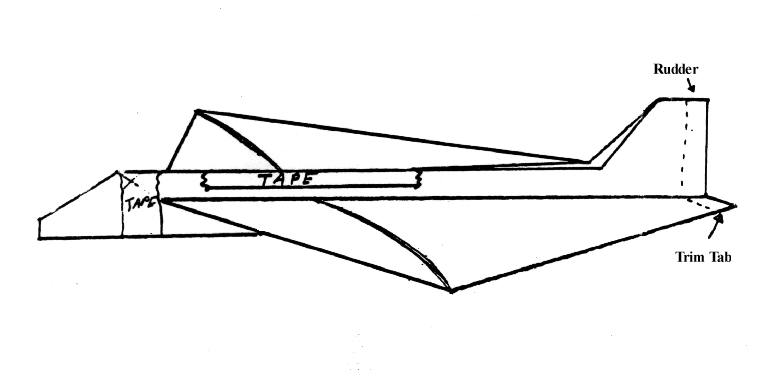

This flying paper model uses an airfoil to produce excellent flying
charecteristics. An airfoil is a special shaped wing that forces air
to move faster across the upper surface than it does across the lower surface.
The faster moving air creates a low pressure area on top of the wing resulting
in an upwards force from the higher presssure air below. The science behind
this effect is explained by Bernoulli’s Principle.

|
Fold a standard (8.5" x 11") piece of paper, 7 cm from one end. |

|
Fold paper down center. |

|
Fold two outer corners to center and tape in place. |

|
Fold both wings down on a line 2 cm from the bottom of the fuselage. |

|
Fold both wings up on a line 1 cm from the the top of the fuselage. |

|
Cut both wings, as shown, on the dotted line. |

|
Hold the wings up out of the way and cut the fuselage
on the dotted lines. A = 2 cm, B = 3 cm. |
Final Assembly:
Push tail up to top of fuselage. Fold
sharp point of nose back in. Wrap tape around shoulder at front. Tape
the fuselage together along the top.

This model flys best in calm conditions. A gymnasium is an excellent place to experiment.
Folding the trim tabs down will cause the model to dive,
folding them up will cause it to climb.
Twisting the rudder left or right will cause the model to
turn that way.
Adding weight (a paper clip is perfect) to the fuselage will
change flying characteristics.
Try moving the weight along the fuselage.

This stepped air foil creates a longer path over top of the wing.
Air travels faster across the top creating lower pressure and lift.
Bernoulli's principle states that when some portions of a fluid (gas, liquid)
system are moving faster then others, the fastest moving fluid will create
the least pressure.
Bernoulli's principle was named for Daniel Bernoulli (1700-1782), a
Swiss mathematician.
Some Bernoulli links: